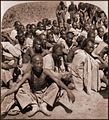| DescrizioneBoxer Prisoners Captured By 6th US Cavalry, Tientsin, China (1901) Underwood & Co (RESTORED) (4072872709).jpg |
Entitled: Some of China's trouble-makers - "Boxer" prisoners captured and brought in by 6th U.S. Cavalry, Tientsin, China [1901] Underwood & Co. [RESTORED] The picture was retouched to eliminate spotting and obvious defects; tonal range was expanded to reveal better details in the shadows; cropped as single image from right side of double imaged stereoscope print, and mildly sepia toned.
The title is not accurate, as it is now believed that most of the supposed Boxer prisoners caught by Foreign troops were just innocent bystanders. Nonetheless, the US Library of Congress, where this historic image resides (under Reproduction Number LC-USZ62-68811), maintains the original title as it was historically written or described by the person(s) that originally made or produced the photograph.
Original was taken by a photographer employed by the Underwood & Underwood Company. Underwood was one of several companies at the time, whose business purpose was to send photographers to all parts of the world to photographically record interesting events in the hopes of selling the pictures to domestic customers. The double imaged pictures were recorded with a special stereo camera; that is, a camera fitted with two lenses side by side. This optical arrangement mimicked the natural and mildly divergent views of each eye that is necessary for human depth perception. When the resultant processed image was placed at a correct distance from both eyes (using a standardized picture holder - viewer), it reproduced a false sense of depth perception. This effectively made the image seem three dimensional and slightly more authentic, giving the viewer a feeling that they were witnessing the actual real life event. Thousands of these stereoscopic photos were sold in their day, and many may still be found tucked away in the old forgotten boxes of a grandparent's basement or attic.
Additionally, black and white photography at that time was limited in terms of how the film perceived the colors of the spectrum. Most films were termed orthochromatic, that is, the film was sensitive to the Blue and Greens but was a poor recorder of the Red end of the spectrum. Thus, the skin tone of darker Asians, especially those worked in the sun and were well tanned, tended to be rendered much darker. This gave many Chinese in early black and white photographs darker skin tones, making them appear more African than Asian. In later years, this phenomenon faded with the introduction of Panchromatic films; that is, film with emulsions that were equally sensitized to all the colors of the spectrum.
This picture is a cue to a lot of history. Taken about one year after the suppression of the "Boxers" (as the Chinese participants were known to the foreigners) these men were reportedly captured from the surrounding areas outside of Tientsin, China. The foreign powers had sought to purge and punish the responsible participants that had brought about the rebellion the year before (in 1900). Knowing little and caring even less about the locals, the foreign troops stated mission was to raid supposed Boxer stronghold villages to capture criminal Boxer participants that were still at large and to bring them to justice. However, what they effectively engaged in was pillaging, rape, and razing operations; essentially reprisals for the Chinese wounding of the Europeans. Prisoners that were not killed outright were brought back into the city for show trials and public executions. These expeditions snared mostly farmers, field hands, and otherwise uninvolved and innocent local Chinese. Under agreement with a Qing government that was more worried with preserving its monarchy than to concern itself with jurisprudence, thousands of Chinese were thus rounded up and executed by either western military or an acquiescing Chinese imperial authority. This heinous treatment of the Chinese populace by foreigners drove home the point that the Qing were no longer able to control China, and within this perceived power vacuum, the stage for China's transformation into a republic was ultimately set. |



